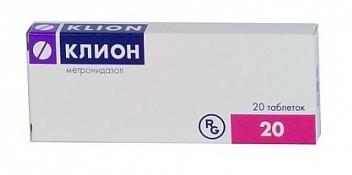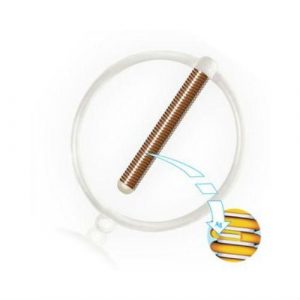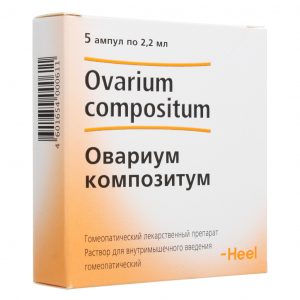Description
Latin name
Klion
release form
White or white tablets from yellowish-green to light yellow with a greenish tint, flat-cylindrical, with a bevel on both sides and a risk on one side.
packaging 10 pcs – blister packs (2) – packs of cardboard.
Pharmacological action
Antimicrobial, antiprotozoal, antibacterial.
Indications
protozoal infection: extraintestinal amoebiasis, incl. amoebic liver abscess, intestinal amoebiasis (amoebic dysentery), trichomoniasis (including trichomonas vaginitis, trichomonas urethritis), balantidiasis, giardiasis, cutaneous leishmaniasis
infections caused by Bacteroides spp. (including Bacteroides fragilis, Bacteroides ovatus, Bacteroides thetaiotaomicron, Bacteroides distasonis, Bacteroides vulgatus): infections of bones and joints, central nervous system infections (including meningitis, brain abscess), bacterial endocarditis, pneumonia, empyema and lung abscess
infections caused by Clostridium spp., Peptococcus spp., Peptostreptococcus spp .: abdominal infections (peritonitis, liver abscess), pelvic infections (endometritis, abscess phalloplops tubes and ovaries, vaginal vaginal infections after surgery), skin and soft tissue infections
pseudomembranous colitis (associated with antibiotics)
gastritis or duodenal ulcer associated with Helicobacter pylori
eoperatsionnyh complications (particularly after surgery on the colon, okolorektalnoy area, appendectomy, and after gynecological operations)
radiotherapy patients with tumors – as a radio facilities in cases when tumor resistance is due to hypoxia in the tumor cells.
Contraindications
organic damage to the central nervous system (including epilepsy)
liver failure (if the drug is administered in high doses)
leukopenia (including history)
I trimester of pregnancy
lactation (breastfeeding)
children under 3 years old (for this dosage form)
sensitivity to the components of the drug.
Precautions: II and III trimesters of pregnancy, renal / hepatic insufficiency
Use during pregnancy and lactation
The drug is contraindicated for use in the first trimester of pregnancy and during breastfeeding.
Composition
1 tab.
metronidazole
250 mg
Excipients:
corn starch,
microcrystalline cellulose,
glycerol,
povidone,
talc,
silicon dioxide colloidal magnesium,
.
How to use and dose
Tablets are taken orally during or after meals (with milk).
Trichomoniasis: adults are prescribed 250 mg 2 times / day for 10 days or 400 mg 2 times / day for 5-8 days. Women need to additionally prescribe metronidazole in the form of vaginal suppositories or tablets. If necessary, you can repeat the course of treatment or increase the dose to 0.75-1 g / day. Between courses, you should take a break of 3-4 weeks with repeated control laboratory tests.
An alternative regimen is to administer 2 g once to the patient and his sexual partner.
For children aged 2-5 years, the drug is prescribed at a dose of 250 mg / day, at the age of 5-10 years – 250-375 mg / day over 10 years – 500 mg / day. The daily dose should be divided into 2 doses. The course of treatment is 10 days.
Giardiasis: adults are prescribed 500 mg 2 times / day for 5-7 days.
Children over 8 years of age – 500 mg / day (in 2 divided doses), at the age of 5 to 8 years – 375 mg / day, at the age of 3 years and older – 250 mg / day, the daily dose should be divided into 2 doses, the course of treatment is 5 days. The dose of the drug can be 15 mg / kg / day in 3 doses for 5 days.
Asymptomatic amoebiasis (if cysts are detected): adults are prescribed 1-1.5 g daily (500 mg 2-3 times / day) for 5-7 days.
Chronic amebiasis: 1.5 g / day in 3 divided doses for 5-10 days.
Acute amoebic dysentery: 2.25 g / day in 3 divided doses until symptoms cease.
Liver abscess: the maximum daily dose is 2.5 g in 1 or 2-3 doses for 3-5 days, in combination with antibiotics (tetracyclines) and as part of complex therapy.
Children from 3 years old – 1/4 dose of an adult, aged 3-7 years old – 1/3 dose of an adult, aged 7-10 years – 1/2 dose of an adult.
Balantidiasis: 750 mg 3 times / day for 5-6 days.
Ulcerative stomatitis: adults are prescribed 500 mg 2 times / day for 3-5 days. In this case, the drug is not indicated for children.
Pseudomebranous colitis: 500 mg 3-4 times / day.
For the eradication of Helicobacter pylori: 500 mg 3 times / day for 7 days (as part of combination therapy, for example, in combination with amoxicillin 2.25 g / day).
Treatment of anaerobic infection: the maximum daily dose is 1.5-2 g.
Treatment of chronic alcoholism: prescribed at a dose of 500 mg / day for a period of up to 6 (no more) months.
For the prevention of infectious complications: 750-1500 mg / day in 3 divided doses 3-4 days before surgery, or once in a dose of 1 g on the first day after surgery. 1-2 days after surgery (when oral administration is already allowed) – 750 mg / day for 7 days.
For severe renal impairment (CC less than 10 ml / min), the daily dose should be halved.
Side effects of the digestive system: diarrhea, anorexia, nausea, vomiting, intestinal colic, constipation, dry mouth, metallic taste in the mouth, glossitis, stomatitis, pancreatitis.
From the side of the central nervous system and peripheral nervous system: dizziness, impaired coordination of movements, ataxia, confusion, irritability, depression, irritability, weakness, insomnia, headache, cramps, peripheral neuropathy, hallucinations.
From the urinary system: dysuria, cystitis, polyuria, urinary incontinence, urine staining in red-brown color.
From the hemopoietic system: neutropenia, leukopenia.
From the cardiovascular system: decrease in the amplitude of the T wave on the ECG.
Allergic reactions: urticaria, skin rash, flushing of the skin, nasal congestion, fever, arthralgia.
Other: candidiasis.
Drug Interaction
Increases the effect of oral anticoagulants, leading to an increase in prothrombin time.
Similar to disulfiram, it causes ethanol intolerance. Concomitant use with disulfiram can lead to the development of various neurological symptoms (interval between appointment – at least 2 weeks).
Cimetidine inhibits the metabolism of metronidazole, which may increase its serum concentration and increase the risk of adverse reactions.
Inductors of liver microsomal oxidation enzymes (phenytoin, phenobarbital) are able to accelerate the elimination of metronidazole, which leads to a decrease in its plasma concentration.
When co-administered with lithium, it is possible to increase the latter’s plasma concentration and develop symptoms of intoxication.
Not recommended for use in combination with non-depolarizing muscle relaxants (vecuronium bromide).
Sulfanylamides enhance the antimicrobial action of metronidazole.
Overdose
Symptoms: nausea, vomiting, ataxia.
Treatment: There is no specific antidote.
Symptomatic therapy is performed.
Storage conditions
The drug should be stored in a dark place at a temperature of 15 ° to 30 ° C.
Expiration
5 Chron
Deystvuyuschee substances
metronidazole
pharmacy terms with prescription
dosage form
dosage form
tablets
Gedeon Richter Vengriya




